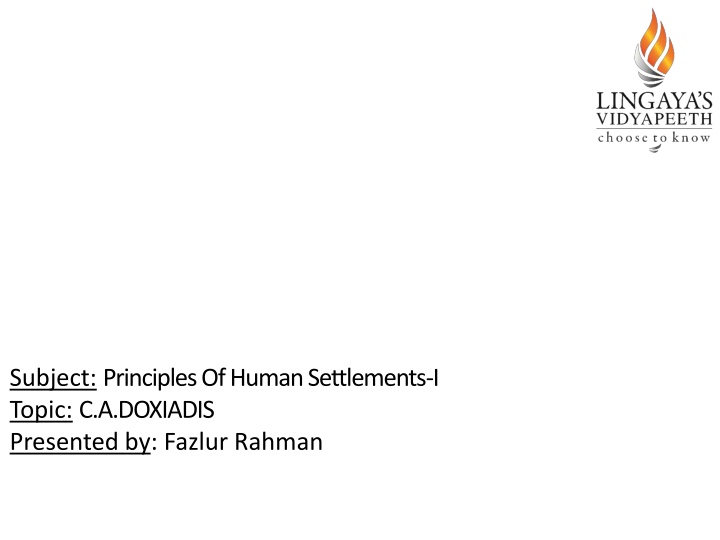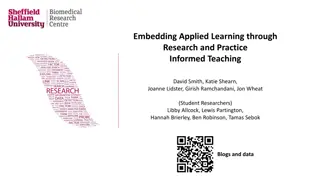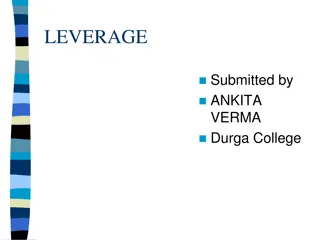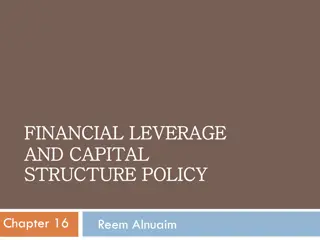
High-Leverage Online Teaching Practices and Research Highlights
This content delves into the concept of high-leverage online teaching practices, focusing on key definitions, examples, and assumptions, as well as research findings in teacher education. It examines the impact of these practices on student learning and offers insights on how novice teachers can effectively develop and implement them in their teaching. Through discussions and shared examples, the importance of proficiency in high-leverage practices for promoting student learning across various contexts is emphasized.
Download Presentation

Please find below an Image/Link to download the presentation.
The content on the website is provided AS IS for your information and personal use only. It may not be sold, licensed, or shared on other websites without obtaining consent from the author. If you encounter any issues during the download, it is possible that the publisher has removed the file from their server.
You are allowed to download the files provided on this website for personal or commercial use, subject to the condition that they are used lawfully. All files are the property of their respective owners.
The content on the website is provided AS IS for your information and personal use only. It may not be sold, licensed, or shared on other websites without obtaining consent from the author.
E N D
Presentation Transcript
Subject: Principles Of Human Settlements-I Topic: C.A.DOXIADIS Presented by: Fazlur Rahman
Dimensions increase and will continue to increase for a few generation and thus the most probable future in definable terms will mean a very large increase of population and energy in the city of Anthopos(man). This is the city where the whole mankind will live or tend to live. C.A.DOXIADIS
Constantinos Constantinos A. A. Doxiadis Doxiadis Born 1913 comes from a family that played an important role in the settlement of Greek war refugees in between the two World Wars Worked Chief Town Planning Officer, Greater Athens Area (1937 - 1938). Head, Department of Regional and Town Planning, Ministry of Public Works, Greece (1939 - 1945). Major Projects In the application of his theories on Ekistics, C.A. Doxiadis studied, programmed,planned and designed, in collaboration with his colleagues, a great number of human settlements and other development projects. These projects cover several fields, like rural settlements, agriculture and irrigation, industrial settlements, manufacturing, power and public works, commerce and tourism, transportation and communications, housing, urban renewal and developmentof new cities,etc.
Ekistics Framework Doxiadis posited a convenient way of organizing information and mapping out the components and relationships of the elements within the human settlements realm. He suggests to have a Classificatory System that will be a methodology to establish the hierarchical structure and links among elements of a system. His two Classificatory Dimensions... 1. First Dimension- relative to Scale: * Lower End- the individual, the room, and the dwelling; and increases in size all the way into the... * Other Extreme- the city, the urban continent, and the "world-wide city"--which he called an Ecumenopolis 2. Second Dimension- man's five Environmental Elements: * Nature * Society * Shells * Networks * Culture
analysis To achieve this we must clarify what we mean by cities. If we have the wrong conception -- for example, that cities are all like the City of London, densely built, small, traditional central parts of urban areas, or like the city of New York, multimillion people agglomerations with many skyscrapers -- we cannot go very far. In all these cases we fail, not because the cities of the future may not be like these prototypes, but because we approach our subject with preconceived ideas about numbers of people, physical size, buildings, and styles which are a major hindrance to the conception of the cities of the future. Preston in Lancashire presents the confusion created by the random development of cities in the 19th century.
ANALYSIS According to Doxiadis, the greatest problem facing cities worldwide was the problem of managing growth. He proposed several solutions to leave room for expansion of the city core. SOME OF HIS PROPOSALS INCLUDED: Limiting all buildings to three levels or less, with permission to build higher Separating automobile and pedestrian traffic completely. Constructing cities as a "beehive" of cells each no bigger than 2 by 2 kilometers, the maximum comfortable distance for pedestrians. Central mall in a recently built shopping centre outside Los Angeles where pedestrians are able to move free of automobile traffic. Doxiadis limited the number of roads on campus. All the educational buildings are interconnected to permit people to walk from one to the other. Courtyards provide a place for meetings between people.
ANALYSIS The city of the future as conceived by Le Corbusier in 1922 illustrates his belief that man should live in a human. Le Corbusier's scale was at ground level where man could walk in green areas. Green spaces are needed by man, but he must not be restricted to them. The city of the future as conceived by Frank Lloyd Wright is a combination of built-up areas and cultivated landscapes. In part, it is a negation of the city as it does not provide for continuously built-up areas, but for an interplay of machines and buildings
Demand for land (AN INCREASE IN DIMENSION) The centrifugal pattern of population growth was evident since the decade 1981-1991, during which the growth was faster in the rural hinterland or the fringe of the NCT Delhi than in the urban agglomeration proper The natural growth rates during the same period were 2.5% annually in rural areas and 2.1 % in urban areas The urban villages of Delhi. They carry 5-6 times more the population density than the non village areas and caters for mixed land use.
DEMAND FOR LAND (AN INCREASE IN DIMENSION) The villages in the rural-urban interface can be put under three main phases of transformation Pre-transition stage: where the village is close to urban extension areas and gradually starts changing character. Transition stage: where the village comes under the urban extension area and is characterised by very high sub-division outside laldora (the legal line dividing built-up and agricultural lane uses in a village). Post-transition stage: where the villages in close proximity to surrounding planned development gets transformed and almost becomes part and parcel of urban areas with increasing inter dependencies on each other
ARGUMENTS RATHER QUESTIONS Are dimensions actually increasing? Is population growth a boon or a taboo to a society? Do we really need to have control measures to curtail this growth or rather use our intellect, which puts us at par viz a viz animals and other life forms? Why then cities still live, without succumbing to this devastating growth?
What lacks Long term planning is needed to determine whether such lands are destined to become urban or not But that ideal works only if the urban planning is for green field projects. Since most urbanisation is not green field, are our policies encouraging this integration, or is development just chaotic? Today s chaos may be more visible in Delhi, Mumbai, Ahmedabad, Bengaluru, Chennai, Kolkatta & Hyderabad. But more serious chaos is probably in other cities like . Our modern day cities too can be planned in such a manner that limits are set to accommodate a certain population and the city is buffered by an equal area of countryside before another new city is created. This equitable land distribution between the city and the village would be an inter- complementary arrangement. Mega-cities interconnected with high speed transport with green fields in between. Integration, if at all necessary should be evolutionary and not enforced. A city where the scale is within the horizon of the human mind. With the planner no longer planning the city since being overtaken by greedy politicians an builders, emergence of so called millennium city like Gurgaon which lack the minimum social facility is evident.
argument The garden cities were created outside the built-up area (a) in order to avoid its pressures, but later were absorbed by the dynamically expanding city (b). In spite of the continuing surgery, the dynamic city cannot be relieved of pressures; with more roads, more functions move in. The centre has to grow within the built-up area, and the dynamic city is choked to death.
EKISTIC PRINCIPLES DESIRABILITY OUTCOME Maximisation of potential contacts Each individual s need for access to other people, work, goods, and services, is met in ways that score positively in terms of accessibility, technology and cultural appropriateness. People can satisfy their needs (e.g. as above) without having to expend unnecessary time and energy. Minimisation of effort in terms of energy, time and cost Optimisation of Anthropos protective space when alone Optimisation of the quality of Anthropos relationship with the system of life Optimisation in the synthesis of all principles People live in a human scale neighbourhood which is safe and secure, where culturally sensitive provisions meet these needs. People have levels of access to opportunities, and economic and social benefit which are fair and culturally sensitive. The humane habitat exhibits a sensitive balance in the desirability outcomes where quality of life and social justice reinforce the desirability to achieve a sustainable environment. Human scale re-established within the human community as in this one in Mosul, Iraq. Street for pedestrians only in Islamabad, Pakistan.
conclusion The fact that the frame is extra-human does not mean that we cannot create a human scale within it. Man will have to create once more a human scale within an extra human frame, which has many inhuman parts. The key to the solution is the creation of the human community as a part of a much larger city. The problem, therefore, is reshaped as a problem of an organized Ecumenopolis, consisting of many human communities that will be its fundamental cells, interconnected by the tens, hundreds, thousands, and tens of thousands into major urban complexes that will be the parts of Ecumenopolis. In this way, what was a natural human community can be immensely enlarged into a human city. With proper organization of transportation and telecommunications networks, the extra-human scale of the large city can be turned into a human one and the inhuman conditions now existing in many parts of the city can be eliminated. Chandigarh, the new capita! of the Punjab in India, designed by Le Corbusier in the year 1950. The drawing shows the initial master plan by Le Corbusier with the city divided into major sectors within which the human scale is reestablished.
conclusion The centre has to grow within the built-up area, and the dynamic city is choked to death. More and more, man will do all the tasks that present an interest and a challenge and leave everything else to automated process. Ecumenopolis, the unique city of man, will form a continuous, differentiated, but also unified texture consisting of many cells, the human communities. If, in the same system as the preceding figure, we create new arteries and new cities, we can avoid all problems of abnormal growth.
Reason why cities still live Vital cities have marvelous innate abilities for understanding , communicating, contriving and inventing what is required to combat their difficulties. Perhaps the most striking example of this ability is the effect that big cities have had on disease. Cities were once the most helpless and devastated victims of disease, but they became great disease conquerors. All the apparatus of surgery, hygiene, public health measures, etc. which people not only in cities but also outside them depend upon for the unending wars against premature mortality are fundamentally products of big cities and would be inconceivable without big cities. The surplus wealth, the productivity, the close-grained juxtaposition of talents that permit society to support advances such as these are themselves products of our organization into cities, and especially into big and dense cities.
CONCLUSION Man doesn t have the power to change the physical dimensions of the world and also these dimensions are in no way less to accommodate all. Stress should be on imbibing civic sense, and education to help people use there intellect. Dull, inert cities contain the seeds of their destruction. But lively cities, diverse and intense contain the seeds of their own regeneration, with energy enough to carry over for problems and needs outside themselves.
Constantinos Constantinos A. A. Doxiadis Doxiadis Sources: Ekistics: the science of human settlements Ebenezer Howard, Garden Cities of To-morrow John G. Papaioannou, The City of the Future W. W. Wagar, The City of Man Website www.ekistics.org www.doxiadis.org www.csiss.org/classics





















